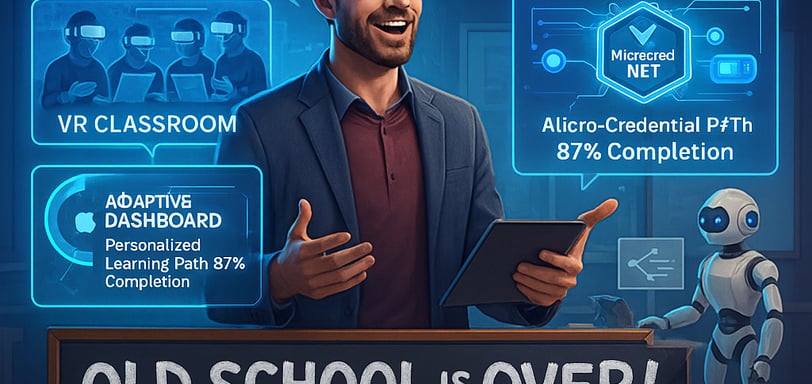The Future of Online Education: Trends Shaping Learning Platforms in 2025
Explore the key trends that will shape the future of online education and how learning platforms can adapt to stay ahead in 2025.
ONLINE LEARNING PLATFORMS
6/4/20253 min read


Introduction
The online education industry has undergone rapid transformation in recent years, driven by technological advancements and changing learner expectations. As we look ahead to 2025, the landscape of online learning is set to evolve even further, with new trends shaping the way we teach and learn.
For learning platforms to stay competitive, it’s essential to anticipate these trends and adapt accordingly. In this article, we’ll explore the key trends that will define the future of online education in 2025 and provide actionable insights to help your platform thrive.
Trend 1: Artificial Intelligence (AI) and Personalization
What It Is: Using AI to deliver personalized learning experiences tailored to individual needs.
Why It Matters: Personalization increases engagement, improves learning outcomes, and makes learners feel valued.
How to Adapt:
Use AI-driven tools to recommend courses based on learner behavior and preferences.
Offer adaptive learning paths that adjust to each learner’s progress.
Implement chatbots for instant support and personalized feedback.
Pro Tip: Platforms like Coursera and Udemy are already leveraging AI for personalized recommendations.
Trend 2: Microlearning and Bite-Sized Content
What It Is: Delivering content in short, focused modules that are easy to consume.
Why It Matters: Microlearning fits into busy schedules and improves knowledge retention.
How to Adapt:
Break courses into 5-10 minute modules focused on specific topics.
Use formats like videos, infographics, and quizzes for quick learning.
Offer mobile-friendly content for on-the-go learning.
Pro Tip: Use tools like EdApp or TalentLMS to create microlearning courses.
Trend 3: Gamification and Interactive Learning
What It Is: Incorporating game-like elements to make learning more engaging and fun.
Why It Matters: Gamification boosts motivation, participation, and knowledge retention.
How to Adapt:
Add badges, leaderboards, and rewards for completing tasks.
Use interactive quizzes, simulations, and challenges.
Create story-based learning experiences to immerse learners.
Pro Tip: Platforms like Kahoot! and Quizlet excel in gamified learning.
Trend 4: Virtual and Augmented Reality (VR/AR)
What It Is: Using VR and AR to create immersive, hands-on learning experiences.
Why It Matters: VR/AR enhances engagement and makes complex concepts easier to understand.
How to Adapt:
Use VR for virtual field trips, lab simulations, or role-playing scenarios.
Use AR for interactive 3D models or real-world applications.
Partner with VR/AR developers to create custom learning experiences.
Pro Tip: Platforms like Engage and zSpace are leading the way in VR/AR education.
Trend 5: Social Learning and Community Building
What It Is: Encouraging collaboration and interaction among learners.
Why It Matters: Social learning fosters engagement, accountability, and peer support.
How to Adapt:
Create discussion forums or chat groups for learners to connect.
Host live Q&A sessions, webinars, or group projects.
Encourage learners to share their progress and achievements.
Pro Tip: Use platforms like Discord or Slack to build learning communities.
Trend 6: Lifelong Learning and Upskilling
What It Is: Offering courses that cater to professionals seeking continuous skill development.
Why It Matters: The demand for upskilling is growing as industries evolve and new technologies emerge.
How to Adapt:
Focus on in-demand skills like coding, data analysis, and digital marketing.
Offer certifications or badges to validate skills.
Partner with employers to create tailored training programs.
Pro Tip: Platforms like LinkedIn Learning and Skillshare are popular for upskilling.
Trend 7: Accessibility and Inclusivity
What It Is: Ensuring your platform is accessible to learners of all abilities and backgrounds.
Why It Matters: Accessibility expands your audience and ensures equal learning opportunities.
How to Adapt:
Use captions, transcripts, and alt text for multimedia content.
Design for screen readers and keyboard navigation.
Offer courses in multiple languages to reach global learners.
Pro Tip: Follow accessibility guidelines like WCAG 2.1 to ensure compliance.
Real-World Example: How a Platform Adapted to Future Trends
Let’s look at a real-world example of how an online learning platform embraced these trends:
The Problem:
A language learning platform struggled to retain users due to outdated content and lack of engagement.
The Solution:
They introduced AI-driven personalized lessons, gamified quizzes, and VR-based immersive experiences.
The Results:
The platform saw a 50% increase in user retention and a significant boost in course completions.
Conclusion
The future of online education is bright, with exciting trends like AI, microlearning, and VR/AR shaping the way we learn. By embracing these trends, your learning platform can stay ahead of the curve, attract more learners, and deliver exceptional educational experiences.
Start preparing for 2025 today, and position your platform as a leader in the online education space!
